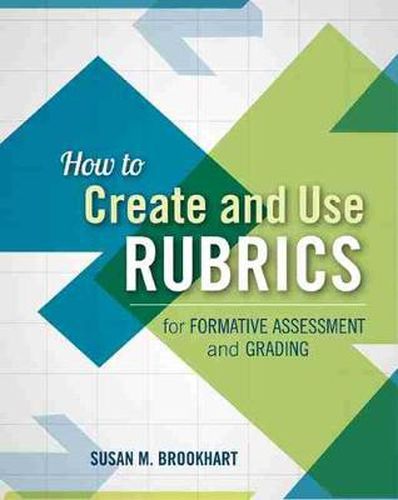Readings Newsletter
Become a Readings Member to make your shopping experience even easier.
Sign in or sign up for free!
You’re not far away from qualifying for FREE standard shipping within Australia
You’ve qualified for FREE standard shipping within Australia
The cart is loading…






What is a rubric? A rubric is a coherent set of criteria for student work that describes levels of performance quality. Sounds simple enough, right? Unfortunately, rubrics are commonly misunderstood and misused.
The good news is that when rubrics are created and used correctly, they are strong tools that support and enhance classroom instruction and student learning. In this comprehensive guide, author Susan M. Brookhart identifies two essential components of effective rubrics: (1) criteria that relate to the learning (not the
tasks ) that students are being asked to demonstrate and (2) clear descriptions of performance across a continuum of quality. She outlines the difference between various kinds of rubrics (for example, general versus task-specific, and analytic versus holistic), explains when using each type of rubric is appropriate, and highlights examples from all grade levels and assorted content areas. In addition, Brookhart addresses:
Common misconceptions about rubrics. Important differences between rubrics and other assessment tools such as checklists and rating scales, and when such alternatives can be useful. How to use rubrics for formative assessment and grading, including standards-based grading and report card grades.
Intended for educators who are already familiar with rubrics as well as those who are not, this book is a complete resource for writing effective rubrics and for choosing wisely from among the many rubrics that are available on the Internet and from other sources. And it makes the case that rubrics, when used appropriately, can improve outcomes by helping teachers teach and helping students learn.
$9.00 standard shipping within Australia
FREE standard shipping within Australia for orders over $100.00
Express & International shipping calculated at checkout
What is a rubric? A rubric is a coherent set of criteria for student work that describes levels of performance quality. Sounds simple enough, right? Unfortunately, rubrics are commonly misunderstood and misused.
The good news is that when rubrics are created and used correctly, they are strong tools that support and enhance classroom instruction and student learning. In this comprehensive guide, author Susan M. Brookhart identifies two essential components of effective rubrics: (1) criteria that relate to the learning (not the
tasks ) that students are being asked to demonstrate and (2) clear descriptions of performance across a continuum of quality. She outlines the difference between various kinds of rubrics (for example, general versus task-specific, and analytic versus holistic), explains when using each type of rubric is appropriate, and highlights examples from all grade levels and assorted content areas. In addition, Brookhart addresses:
Common misconceptions about rubrics. Important differences between rubrics and other assessment tools such as checklists and rating scales, and when such alternatives can be useful. How to use rubrics for formative assessment and grading, including standards-based grading and report card grades.
Intended for educators who are already familiar with rubrics as well as those who are not, this book is a complete resource for writing effective rubrics and for choosing wisely from among the many rubrics that are available on the Internet and from other sources. And it makes the case that rubrics, when used appropriately, can improve outcomes by helping teachers teach and helping students learn.